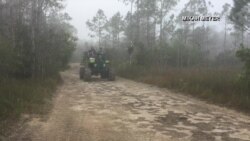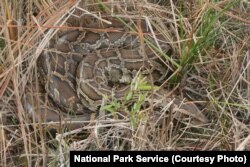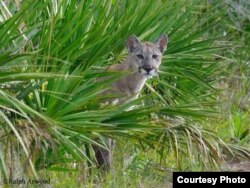Driving through the ancient swamplands of the Big Cypress National Preserve in southern Florida made national parks traveler Mikah Meyer feel like he was in another world.
Ghostly landscape
“Because it was so early, it was super foggy,” he said. “We couldn’t see more than 20- 30 feet in front of us and it was just this ethereal, misty experience."
“At one point we came up against a controlled burn site, so you have these tall trees that were green at the top but then underneath, everything was charred.”
Mikah - who's on a mission to visit all of the more than 400 National Park sites - had just been to Florida’s famous Everglades National Park, so it was natural for him to want to visit the neighboring preserve. “It was on the same road as I took to go to the Everglades -- Highway 41. The Everglades was on the south side; the Big Cypress National Preserve on the right side.”
Western Everglades
“A far less popular park than the Everglades, Big Cypress is a lot more wild,” Mikah noted. The huge cypress swamp, most of which is in Big Cypress National Preserve, is dominated by bald cypress trees that grow in water, which create surreal scenes that are enhanced by fog and smoke.
Ever wonder what it’s like to ride on a swamp buggy? Hop on board with Mikah and his friends...
His guide, Ozzie Gonzalez from Everglades Nature Tours, drove Mikah and his travel companion, Andy Waldron, through the ghostly environment on a swamp buggy, a vehicle that’s specially designed to navigate the area’s rough and muddy terrain. “It had these monster truck wheels that were only four-pounds pressure, and that's basically because you're going over so many rocks and so many holes that it's needed to be light pressure so that the vehicle doesn't break,” Mikah explained.
Big Cypress was actually the first national preserve in the National Park Service, established in 1974. It owes that distinction to a massive community effort. “It was both industry and conservationists, along with hunters and Native people who use this land for their own recreational purposes," Mikah noted, "so it was a real group effort to make sure that it remained in ways that helped everybody.”
Freshwater to the sea
The primary reason the preserve was created was to protect its freshwater's natural flow into the neighboring Everglades and Ten Thousand Islands, and help support the rich marine estuaries along Florida's southwest coast.
“It helps protect the watershed,” Mikah said. “So the water that comes down from Lake Okeechobee, today only 25% of it flows to the Everglades as it did historically. So by having the preserve north of the Everglades, it helps protect the water that comes down into the Everglades...and is the drinking water for half of the people that live in Florida – so over 10 million people -- so that's important.”
Plentiful pythons
Protecting nearly 300,000 hectares of this vast swamp, Big Cypress National Preserve comprises a combination of tropical and temperate plant communities that are home to a diversity of wildlife. That includes the elusive Florida panther, and in more recent years, Burmese pythons, one of the largest snake species on Earth.
The invasive snakes have been turning up in and around Big Cypress National Preserve and are now known to be breeding in the preserve and spreading throughout south Florida.
Mikah said that back in the ‘70s, having exotic pets was a trend. “People would purchase pythons as little, one-foot long baby snakes, which would eventually grow to over 10 feet and you’d have to feed them a pig a week...so all these people were just taking them to the Everglades and Big Cypress and dumping them in nature.”
Now they’ve reproduced, "and have basically taken over the place to the point that some naturalists think there will come a point when they will have eaten all of the other species and at that point they'll start to cannibalize each other,” he said.
Big Cypress National Preserve is working with other government agencies to control the growing Burmese python population and address other invasive species. On its website, the National Park Service notes that the reptiles “serve as a painful reminder of just how dangerous invasive species can be."
Stepping back in time
About 130 kilometers west of Miami, far from the bright lights and bustle of city life, the national parks and preserved spaces in south Florida -- and the wildlife they support -- are also a reminder of what protection can offer... a chance for visitors from around the world to explore a special and fragile place that remains untouched by civilization.
“It was so interesting to be in south Florida because I think when we hear south Florida, we just think of nightclubs on Miami Beach,” Mikah said. “But in reality, the vast majority of the land is made up of Everglades National Park and the Big Cypress National Preserve and so it's important to remember that these two National Park Service sites represent what Florida looked like before human interaction.
“So if you want to step back in time, this is a place you can do it.”
Mikah invites you to learn more about his travels in Florida and all across America by visiting his website, Facebook and Instagram.











